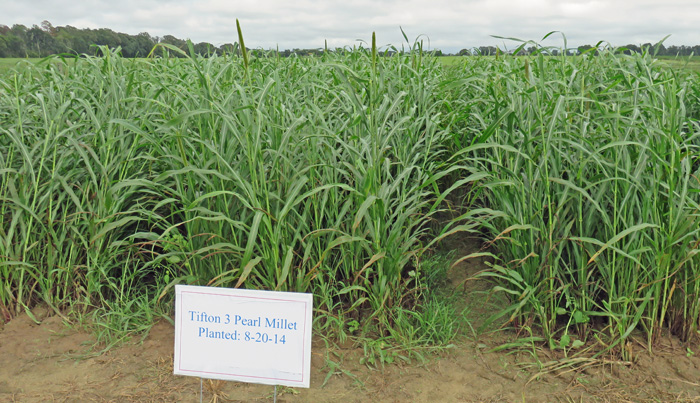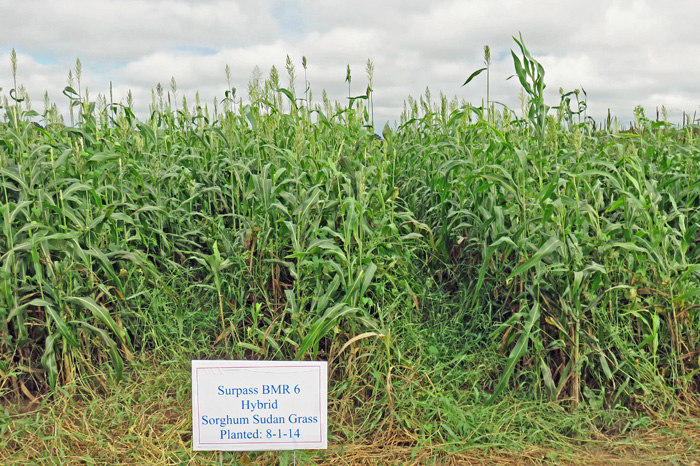
Tifleaf 3 millet planted August 20 and photographed October. 3, 2014 at the NFREC Beef and Forage Field Day. Photo Credit: Doug Mayo
Ann Blount, Forage Breeder, NFREC-Marianna
After a very cold and wet winter across much of the south, many of us are still reeling from low hay inventories and delayed winter forage growth. With the last few days of night temperatures above 50 0F, many of our winter pastures are exploding in growth and grazing conditions have remarkably improved. With warming spring weather most of us in the southern states have summer perennial pastures that have come out of winter dormancy. While the backbone of the southern cattle industry relies on these perennial species, some of us plant a portion of our acres in summer annuals, like millet, sorghum-sudangrass, and crabgrass. These high quality and high yielding forages give livestock, such as stockers, replacement heifers, first-calf heifers, or dairy cows, the high quality forage they need for proper growth and development.
Pearl millet, forage sorghum, sudangrass and sorghum-sudan hybrids are annual, warm-season, seeded grasses that grow quickly in the spring and summer months, and offer both high-yielding and high-quality forage. These forages require cultivated land or may be stripped or no-tilled into a winter pasture following small grains, after the forage has been grazed down. Row crop and vegetable crop producers may also use summer annual grasses in rotation with high valued crops to maintain weed control, and to prevent erosion, while provide their livestock an alternate source of grazing. Sometimes these forages are used when renovating pastures, particularly when trying to eliminate existing stands of perennial grasses. Following a thorough disking, they can planted and successfully shade out remaining bahiagrass and bermudagrass.
While these quick growing annuals offer high nutritive quality, they can present a few management concerns. Nitrate accumulation can occur in all of these grasses. Weather and crop management may contribute to the rapid accumulation of nitrates in the plant tissue. This generally occurs during periods of low rainfall or low humidity with plants heavily fertilized with nitrogen (N). When hay is cut during or just following a period of drought, nitrate levels may be elevated. Prussic acid (HCN) poisoning is not a concern in millet, however, it is with forage sorghum, sudangrass, and sorghum-sudangrass hybrids, so care should be taken with livestock consuming these forages during periods of drought or following frost. [warning]Equine should not be fed sorghum-sudangrass hay because of health issues related to cystitis. Regardless of the class of livestock you are feeding, care needs to be taken to prevent any issues with nitrates and prussic acid concentrations in sensitive animals.[/warning]
Summer annual forages may also be used for creep grazing, green chop, haylage, silage, or hay. The large stems are often hard to dry for making hay, and a hay conditioner would best be used to hasten the drying period. Often these types of summer forages are ensiled rather than harvested for hay.
Pearl millet, forage sorghum, and sorghum-sudangrass seed is often readily available and there are some very good varieties on the market. More information on planting, management and expected yields of these crops can be found in extension publication http://edis.ifas.ufl.edu/ag157
Performance and yield of these annual forage varieties are tested in Florida and Georgia. 2014 University of Florida trial results are found at: http://animal.ifas.ufl.edu/corn_silage_forage_field_day_extension/index.shtml.
Results for the 2014 millet and sorghum-sudangrass trials for University of Georgia’s variety testing website may be found under Summer Annual Forages: http://extension.uga.edu/publications/detail.cfm?number=AP103-6
Pearl millet varieties, include Tifleaf 3, and several other commercially available varieties, are all well adapted to much of the south. Pearl millet should not be confused with Japanese millet, browntop millet, or proso millet. These are short growing millets, popular in wildlife plantings or for quick cover to prevent soil erosion. Forage yields of these millets are considerably lower than that of pearl millet and are not usually recommended for livestock forage plantings.
Some of the forage sorghums and sorghum-sudangrass hybrids now have the brown midrib (BMR) trait, which enhances the digestibility of the forage by as much as 40%. Sudangrass is a finer grass than sorghum-sudangrass and is generally lower yielding.

Surpass BMR 6 Sorghum x Sudangrass planted August 1 and photographed October 3, 2014 at the NFREC Beef and Forage Field Day. Photo credit: Doug Mayo
Lastly, one of my favorite summer annual forages is Crabgrass. It is a fine-stemmed grass that can be grazed or cut for hay. It often volunteers in pastures or fields that have recently been tilled. Crabgrass can be planted, however commercial seed are limited to “Red River Crabgrass,” developed at the Roberts Noble Foundation of Ardmore, Oklahoma and “Quick-N- Big” from Elstel Farms and Seeds, Thomas, OK, and “Mojo Yellow Jacket Coated” crabgrass from Barenbrug USA. Some new crabgrass varieties Crabgrass can be managed as an annually planted forage. It mixes very well with legumes and other types of summer grasses. It is very palatable and has excellent forage quality with CP at about 14% and % IVDMD in the upper 70s (78-79%) when grazed or cut for hay in the vegetative stage. As the plant matures, as with most grasses, its forage quality declines.
Planting crabgrass fits well in open land situations where planting annual winter forages, such as ryegrass, oats, rye or wheat, for early grazing is the goal. The periods for winter annuals and crabgrass are complementary and allow for slight overlap in seasonal forage production. Shallow tillage prior to planting winter annuals incorporates crabgrass seed and usually results in good crabgrass stands the following spring, without the need for spring tillage. When the crabgrass stand is established, fertilization is the primary management practice required. Crabgrass growth in Florida declines by late August or early September. More information about crabgrass can be found in EDIS at http://edis.ifas.ufl.edu/ag195.
Now that the season for summer plantings of annual grass forages is here, let’s hope for timely rains and better growing conditions than this past year’s. Perhaps these summer annual forages might find a fit and help to extend the forage calendar on your livestock operation.
- Cool-Season Forages – A Pasture Perspective for 2022 - September 16, 2022
- Ornamental Rhizoma Perennial Peanut for Groundcover or Alternative Turf - March 18, 2022
- 2021 Cool-Season Forage Recommendations for Livestock and Wildlife - September 24, 2021
